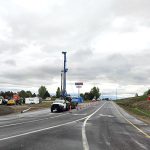Idaho Transportation Department seeks feedback on draft seven-year transportation plan

The Idaho Transportation Department is seeking feedback on the just-released draft Idaho Transportation Investment Program (ITIP). The ITIP outlines the state’s transportation priorities and guides investment decisions for the next seven years through 2032. ITD encourages everyone to review the draft and provide comments July 1-31.
Transportation projects included in the draft ITIP range from large-scale interstate improvements to smaller projects like the installation of new guardrail. Projects are located throughout Idaho’s 44 counties and involve all modes of transportation. Project selection is determined through technical data, as well as input from local officials and residents.
Visit itd.idaho.gov/funding to view an to learn about projects and submit a comment through the portal.
ITD Chief Deputy Director Dan McElhinney outlined, “The Idaho practice of annually updating a seven-year highway transportation plan helps consider the growth of traffic we are all seeing which is accelerating the need for safety, preservation and capacity improvements supporting communities statewide. This draft ITIP presents investment needs in highway pavement, bridge repairs, and congestion relief improvements that will provide the Idaho Transportation Board effective options to consider looking ahead for Idaho.”
In mid-June, the Idaho Transportation Board accepted staff recommendations to address congestion on priority corridors using Transportation Expansion and Congestion Mitigation funds. These funds came from House Bill 25, which was passed by the Idaho Legislature earlier this year. The legislation provides an additional $20 million a year to the TECM fund for the next three years and allows the department to invest an extra $1 billion in the Idaho transportation system.
One of the major project(s) in the draft ITIP affecting East Idaho as part of the board’s action include:
- US-20 west of Idaho Falls. This project will increase capacity by widening the road to two lanes in each direction starting at Idaho Falls and moving west as funding allows. Widening will increase safety for freight, recreational and commuter traffic due to limited passing opportunities and lines of sight. Construction is anticipated start in 2026, two years earlier than planned.
Comments can be emailed to itipcomments@itd.idaho.gov, recorded at 208-334-8063 or mailed to:
ITIP – Comments
Attn: Noah Ipaye
P.O. Box 7129
Boise, ID 83707
Paper copies of the ITIP will be available at regional offices and provided upon request by contacting the Idaho Transportation Department at 208-334-8284.
After approval by the Idaho Transportation Board in September, the ITIP will then be submitted to the Federal Highway Administration, the Federal Transit Administration, and the Environmental Protection Agency in October.
Public input is crucial in ensuring that the ITIP includes the prioritized needs of Idaho’s communities.

















